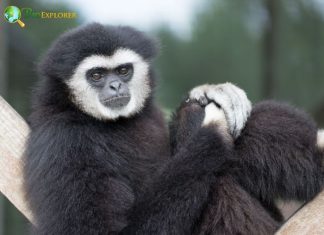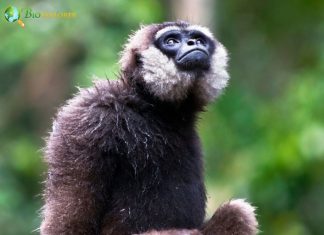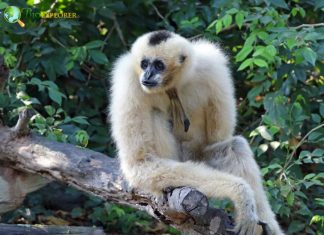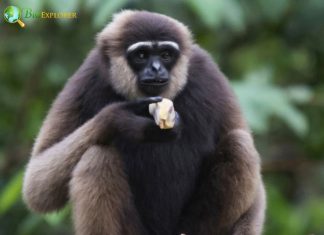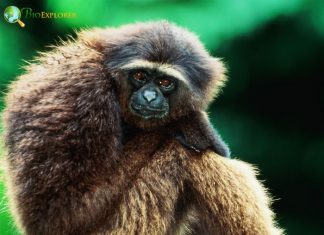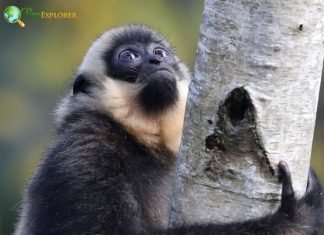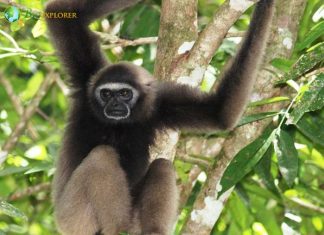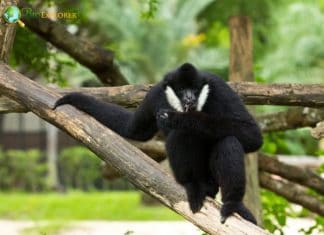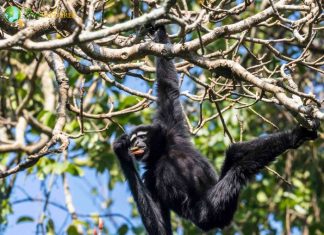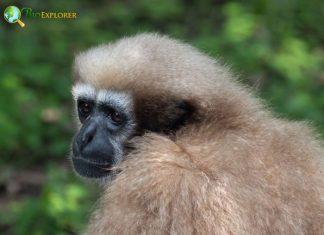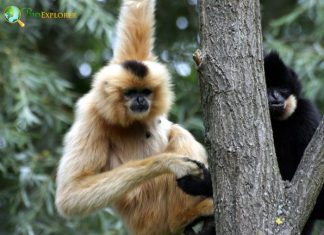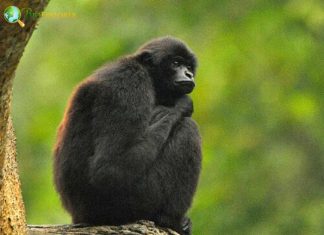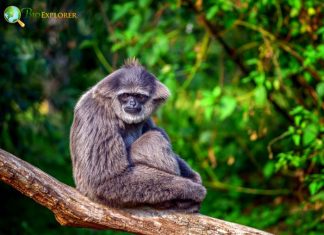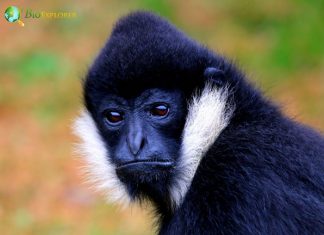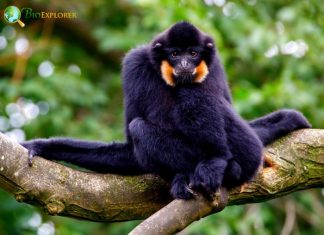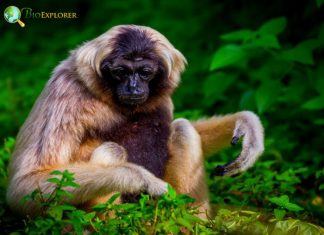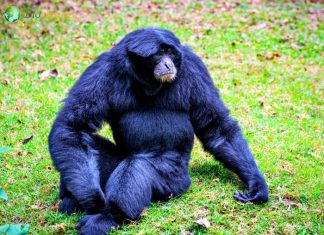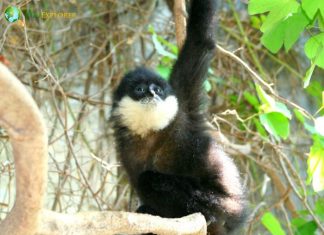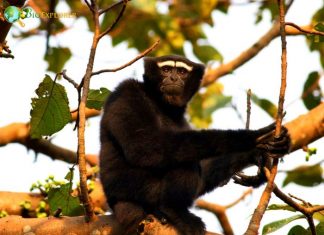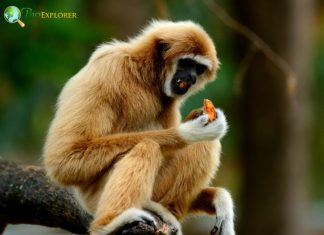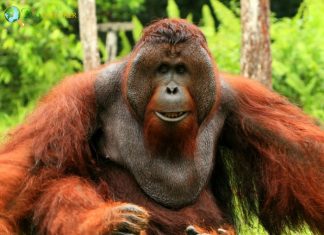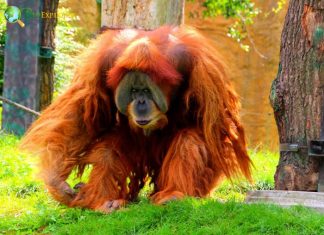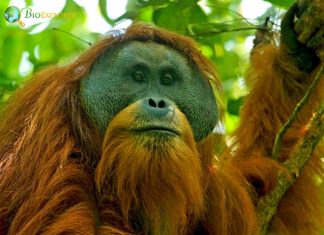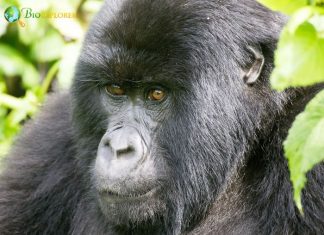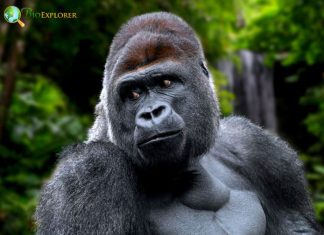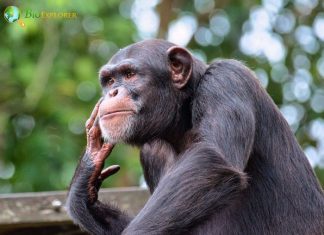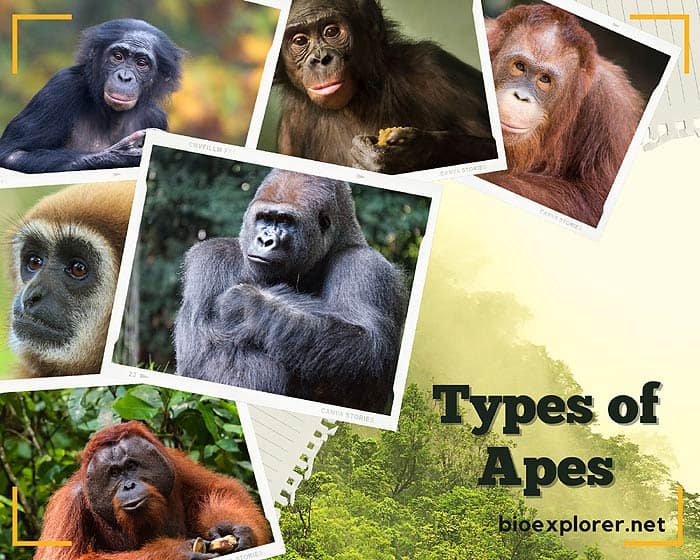
Types of Apes: There are two main types of apes: “lesser apes” and “great apes“. Lesser apes include mainly all gibbon species, whereas the Great apes include orangutans, gorillas, chimpanzees, and bonobos.
Great apes and humans belong to the same primate group called hominoids despite differences in limb length and jaw shape; their bone structure similarities can be noticed. However, apes and humans are not directly related.
Humans belong to a separate division of the hominoid family called the hominids. This group includes modern humans (Homo sapiens sapiens) and our direct ancestors.
Recent genetics research indicates that the hominid and ape lineages may have diverged about 7 to 9 million years ago[1].
Types of Apes
Here are two main kinds of apes namely:
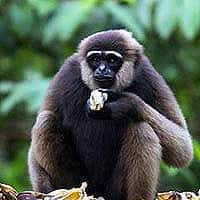
Lesser Apes
Gibbons (also called lesser apes) belong to the family Hylobatidae, and there are 20 discovered species. Gibbons live in sub-tropical and tropical rainforests of Bangladesh, India, China, and the Indonesian islands. All gibbons are tailless and smaller in size when compared to Great apes.
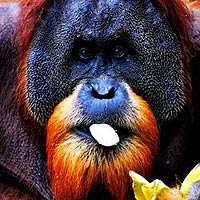
Great Apes
The Hominidae family members are great apes or hominids. This taxonomic primate contains four genera, namely Pongo (Orangutans), Gorilla (East and West Gorillas), Pan (Chimpanzees & Bonobos), and Homo (modern humans).
-
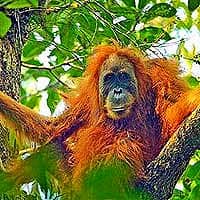
Orangutans
These great apes are native to Indonesia and Malaysia’s rainforests but are found only in Borneo and Sumatra islands. There are only 3 known species of orangutans under the genus Pongo.
-
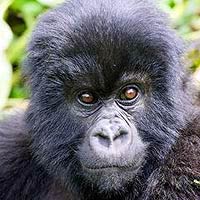
Gorillas
Gorillas are plant-eating primates, mostly ground-dwelling great apes found in equatorial African tropical forests. The genus Gorilla comprises two species: the eastern and western gorilla. The DNA of gorillas is more similar to that of humans. So, gorillas are the closest relatives to humans after Chimpanzees and Bonobos.
-
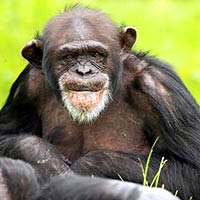
Chimpanzees
The chimpanzee (also called chimp or common chimpanzee, or robust chimpanzee) is another great ape found in the forest and savannah of tropical Africa. Chimpanzees are the closest relatives to humans.
-
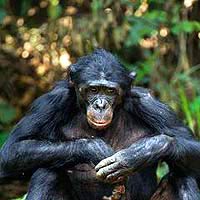
Bonobos
The bonobo (also called the pygmy chimpanzee) is an endangered great ape and another species in the genus Pan. Bonobos were initially thought to be a subspecies of chimpanzees due to their physical similarities, but they are now a separate species.
-
Gibbons
Abbott’s Gray Gibbon
Species Name: Hylobates abbottiAgile Gibbon
Species Name: Hylobates agilisBlack-Crested Gibbon
Species Name: Nomascus concolorBornean White-Bearded Gibbon
Species Name: Hylobates albibarbisBornean Gibbon
Species Name: Hylobates muelleriSouthern Yellow-Cheeked Gibbon
Species Name: Nomascus gabriellaeEastern Gray Gibbon
Species Name: Hylobates funereusEastern Black-Crested Gibbon
Species Name: Nomascus nasutusEastern Hoolock Gibbon
Species Name: Hoolock leuconedysSkywalker Hoolock Gibbon
Species Name: Hoolock tianxingHainan Black-Crested Gibbon
Species Name: Nomascus hainanusKloss’s Gibbon
Species Name: Hylobates klossiiSilvery Gibbon
Species Name: Hylobates molochNorthern White-Cheeked Gibbon
Species Name: Nomascus leucogenysNorthern Buffed-Cheeked Gibbon
Species Name: Nomascus annamensisPileated Gibbon
Species Name: Hylobates pileatusSiamang Gibbon
Species Name: Symphalangus syndactylusSouthern White-Cheeked Gibbon
Species Name: Nomascus sikiWestern Hoolock Gibbon
Species Name: Hoolock hoolockLar Gibbon
Species Name: Hylobates lar![]()
Orangutans
Bornean Orangutan
Species Name: Pongo pygmaeusSumatran Orangutan
Species Name: Pongo abeliiTapanuli Orangutan
Species Name: Pongo tapanuliensis![]()
Gorillas
Eastern Gorilla
Species Name: Gorilla beringeiWestern Gorilla
Species Name: Gorilla gorilla![]()
Chimpanzees and Bonobos
Common Chimpanzee
Species Name: Pan troglodytesBonobo
Species Name: Pan paniscus![]()
Types of Apes by Taxonomists
Here is the list of apes by taxonomists sorted by the year of classification:
| Bornean Orangutan | 1760 | Carl Linnaeus | Swedish botanist, zoologist, taxonomist, and physician |
| Lar Gibbon | 1771 | Carl Linnaeus | Swedish botanist, zoologist, taxonomist, and physician |
| Moloch Gibbon | 1798 | Jean-Baptiste Audebert | French artist and naturalist |
| Chimpanzee | 1799 | Johann Friedrich Blumenbach | German physician, naturalist, physiologist, and anthropologist |
| Agile Gibbon | 1821 | Georges-Fréédééric Cuvier | French zoologist and paleontologist |
| Siamang Gibbon | 1821 | Stamford Raffles | British statesman |
| Black-crested Gibbon | 1826 | Richard Harlan | American paleontologist, anatomist, and physician |
| Sumatran Orangutan | 1827 | Renéé Lesson | French surgeon, naturalist, ornithologist, and herpetologist |
| Western Hoolock Gibbon | 1834 | Richard Harlan | American paleontologist, anatomist, and physician |
| Northern White-cheeked Crested Gibbon | 1840 | William Ogilby | Irish-born zoologist |
| Borneo Gibbon | 1841 | William Charles Linnaeus Martin | English naturalist |
| Western Gorilla | 1847 | Thomas Staughton Savage | American Protestant clergyman, missionary, physician, and naturalist |
| East Bornean Gray Gibbon | 1850 | Isidore Geoffroy Saint-Hilaire | French zoologist |
| Pileated Gibbon | 1861 | John Edward Gray | British zoologist |
| Eastern Black-crested Gibbon | 1884 | Philippe Alexandre Jules Küünckel d’Herculais | French entomologist and zoologist |
| Hainan-crested Gibbon | 1892 | Oldfield Thomas | British zoologist |
| Eastern Gorilla | 1903 | Paul Matschie | German zoologist |
| Kloss’s Gibbon | 1903 | Gerrit Smith Miller Jr. | American zoologist and botanist |
| Buff-cheeked Gibbon | 1909 | Michael Rogers Oldfield Thomas | British zoologist |
| Bornean White-bearded Gibbon | 1911 | Marcus Ward Lyon Jr. | American mammalogist, bacteriologist, and pathologist |
| Abbott’s Gray Gibbon | 1929 | C. Boden Kloss | English zoologist |
| Southern White-cheeked Crested Gibbon | 1951 | Jean Thééodore Delacour | French ornithologist and aviculturist |
| Eastern Hoolock Gibbon | 1967 | Colin Groves | British-Australian biologist and anthropologist |
| Northern Yellow-cheeked Crested Gibbon | 2010 | Van Ngoc Thinh, Alan R. Mootnick, Vu Ngoc Thanh, Tilo Nadler, Christian Roos | German Primatologists |
| Gaoligong Hoolock Gibbon | 2017 | Peng-fei Fan, Kai He, Xing Chen, Alejandra Ortiz, Bin Zhang, Chao Zhao, Yun-Qiao Li, Hai-bo Zhang, Clare Kimock, Wen-Zhi Wang, Colin P. Groves, Samuel T. Turvey, Christian Roos, Kristofer M. Helgen & Xue-Long Jiang. | Many Chinese Primatologists |
| Tapanuli Orangutan | 2017 | Nurcahyo, Meijaard, Nowak, Fredriksson, & Groves in Nater, Mattle-Greminger, Nurcahyo, Nowak, de Manuel, Desai, Groves, Pybus, Sonay, Roos, Lameira, Wich, Askew, Davila-Ross, Fredriksson, de Valles, Casals, Prado-Martinez, Goossens, Verschoor, Warren, Singleton, Marques, Pamungkas, Perwitasari-Farajallah, Rianti, Tuuga, Gut, Gut, Orozco-terWengel, van Schaik, Bertranpetit, Anisimova, Scally, Marques-Bonet, Meijaard & Krutzen | Many Primatologists |
![]()


